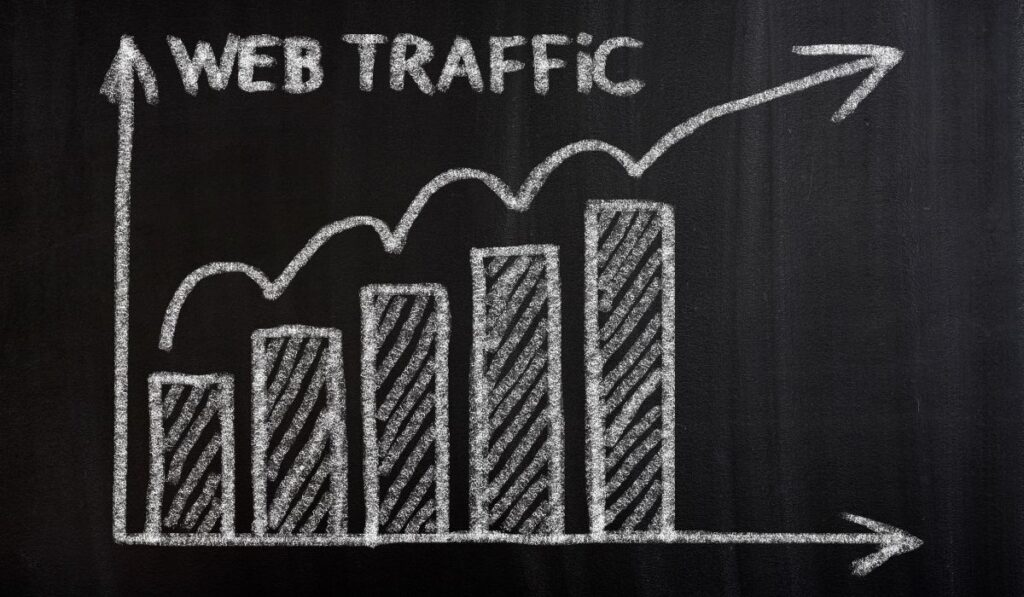Did you know 93% of all online experiences start with a search engine? This fact shows how vital it is to understand where website traffic comes from. At Zen 9 Marketing, we know how important analyzing traffic is for digital marketing strategies.
In this guide, we’ll look into website analytics, focusing on direct and organic traffic. Knowing the differences between these can help you improve your online presence and grow.
Let’s see how these traffic sources affect your site’s performance. This knowledge will help you make better decisions for your digital marketing. Whether you’re experienced or new, understanding website traffic is key for success online.
Key Takeaways
- Direct traffic often makes up 5-20% of total visits in Google Analytics 4
- Organic traffic can be 50-70% of total web traffic for SEO-optimized sites
- Up to 80% of link sharing happens through dark social channels
- Direct traffic usually means higher user engagement and intent
- Organic traffic shows how well SEO strategies work
- Websites with strong SEO can see a 5-10x increase in organic traffic
Understanding Website Traffic Sources
Website traffic sources are key to knowing how people find and use your site. We’ll look at the different types of traffic and how analytics tools help spot them.
Different Types of Traffic Classification
Traffic sources fall into several categories:
- Organic search: Visitors who find your site through search engines
- Paid search: Traffic from sponsored ads on search engines
- Direct: Users who type your URL or use bookmarks
- Referral: Visitors from links on other websites
- Social: Traffic from social media platforms
Knowing the balance between paid search and organic search is vital for a good content marketing strategy. Organic traffic usually makes up a big part of visits, showing your SEO is working well.
The Role of Analytics Tools
Analytics tools are crucial for tracking and sorting website traffic sources. They use complex algorithms to figure out where visitors come from. This gives insights into how users behave and how your site performs.
Traffic Source Identification Methods
Identifying traffic sources means analyzing:
- Referring URLs
- Search engine queries
- Campaign parameters
- User behavior patterns
By understanding these methods, you can better understand your site’s analytics. This helps you make smart choices for your marketing plans.
Direct vs Organic Traffic: Key Differences and Characteristics

It’s important to know the difference between direct and organic traffic. Direct traffic comes from users typing your URL or using bookmarks. This shows strong brand loyalty. On the other hand, organic traffic comes from search engines, showing your site’s relevance and visibility.
Let’s look at the main points of each:
- Direct traffic makes up 20-30% of all website visits.
- Organic traffic can be up to 60% for well-optimized sites.
- Direct traffic users stay longer, 30-40% more than others.
- Organic traffic has higher conversion rates, up to 14%, compared to 2% for paid ads.
Interestingly, direct vs organic traffic shows different user behaviors. Direct visitors usually know your brand and convert more. Organic visitors are new but actively looking for solutions, helping your site grow over time.
To make the most of both, work on consistent branding for direct traffic. Also, improve your SEO for organic growth. Don’t forget about referral traffic too. By balancing these, you’ll have a strong traffic mix that boosts your online success.
Demystifying Organic Traffic
Organic traffic is crucial for many websites’ success. It’s when people find your site through search engines like Google, without seeing ads. Knowing about organic search helps grow your online presence.
Search Engine Result Pages (SERPs)
SERPs are where the magic happens. When users search, search engines show a list of web pages. Your goal is to rank high in these results. The higher you rank, the more likely people will visit your site.
Role of SEO in Organic Traffic
Search Engine Optimization (SEO) is key for more organic traffic. It makes your site better for search engines, helping you rank higher. SEO is essential today, as it boosts your site’s visibility to potential customers.
Measuring Organic Traffic Success
To see how well your SEO works, track these:
- Number of organic visitors over time
- Bounce rate
- Average session duration
- Conversion rate from organic traffic
By looking at these, you can make your SEO better. Remember, organic traffic is valuable for the long run, offering cost-effective results.
Breaking Down Direct Traffic Sources
Direct traffic is a big part of website analytics, making up 22% of all visits. Let’s look at the different sources that make up this important part of your site’s traffic.
URL Direct Entry and Bookmarks
When users type your website’s URL or use bookmarks, it’s direct navigation. This traffic usually comes from people who know and love your brand. They tend to stay longer and engage more with your site.

Email Client Referrals
Email marketing can sometimes look like direct traffic in analytics. This is because of how some desktop email clients work. To really track email marketing traffic, use UTM parameters in your links.
Mobile App Traffic
Mobile app traffic often shows up as direct in analytics. This includes users who visit your site through in-app browsers or special app features. As more people use mobile devices, knowing about this traffic source is key for good analytics.
| Direct Traffic Source | Characteristics |
|---|---|
| URL Direct Entry | High brand loyalty, low bounce rates |
| Email Client Referrals | Potential misattribution, requires UTM tracking |
| Mobile App Traffic | Growing importance, often miscategorized |
Understanding these direct traffic sources helps us make sense of our analytics. We can then plan better to get more direct visits to our website.
Common Causes of Miscategorized Direct Traffic
Direct traffic in website analytics isn’t always as it appears. A big part of what’s labeled as “direct” is often mislabeled. This can make your data look wrong and mess up your marketing plans.
One big problem is untagged links in emails. Without UTM tags, Google Analytics might think email traffic is direct. This means you might not see how well your emails are working.
Another issue is when HTTPS sites send users to HTTP sites. This can lose referral data, making your website traffic look wrong. Bad redirects and missing tracking codes also cause problems.
Groupon found out that 60% of their “direct” traffic was actually organic. This was because some source info was missed.
To get your traffic analysis right:
- Always use UTM tags in your marketing
- Keep an eye on your Traffic Acquisition report for odd trends
- Make sure your site uses the same HTTPS everywhere
Fixing these issues will help you understand your referral traffic better. This way, you can make smarter marketing choices.
The Impact of HTTPS on Traffic Classification
Website traffic sources and referral traffic analysis have become more complex with the widespread adoption of HTTPS. This secure protocol has changed how we track and classify visitor data.
Security Protocols and Referral Data
The shift to HTTPS has significantly impacted referral traffic tracking. When users move from an HTTPS site to an HTTP site, referrer data is often lost. This security measure can lead to misclassification of traffic sources.
SSL Certificates and Traffic Tracking
SSL certificates play a crucial role in maintaining accurate traffic data. Without proper implementation, websites may see a spike in direct traffic that’s actually from other sources. This can skew analytics and lead to misguided marketing decisions.
| Traffic Type | HTTP to HTTP | HTTPS to HTTP | HTTPS to HTTPS |
|---|---|---|---|
| Referral | Preserved | Lost | Preserved |
| Direct | Accurate | Inflated | Accurate |
| Organic | Accurate | Potentially Misclassified | Accurate |
Understanding these changes is vital for accurate traffic analysis. By implementing SSL and using tracking parameters, we can maintain reliable data on website traffic sources and make informed decisions about our digital strategies.
Maximizing Organic Traffic Growth
Growing organic traffic is crucial for website success. At Zen 9 Marketing, we use strategies to boost your visibility in organic search results. We combine content optimization, keyword research, and technical SEO for lasting growth.
Content Strategy Optimization
We create engaging, search-optimized content that connects with your audience. Our high-quality blog posts can increase website visitors by 55%. This can lead to a 500% boost in organic traffic in just a few months.
Keyword Research and Implementation
Our team does deep keyword research, focusing on long-tail keywords that make up 70% of searches. We target these phrases to capture specific user intent and boost your search rankings.
Technical SEO Considerations
We apply technical SEO best practices to improve your site’s performance. This includes optimizing page speed, improving site structure, and ensuring mobile-friendliness. These efforts can lead to a steady 3-5% monthly increase in organic traffic.
By focusing on organic search strategies, we help you access a traffic source that makes up 51% of all website visits. Unlike paid search vs organic search, SEO offers long-term benefits without ongoing financial costs. Our aim is to get your site on the first page of Google, where 91.5% of search traffic resides.
Tracking and Analyzing Traffic Patterns
Knowing where your website traffic comes from is key for good online marketing. We’ll look at how to track and analyze traffic to make your site better. Organic traffic, making up 51% of all visitors, is especially important for businesses.
- Page views
- Session duration
- Bounce rate
- Pages per session
- Conversion rate
- Exit rate
- New vs. returning visitors
These metrics show how visitors use your site. A high bounce rate might mean your content isn’t what visitors want. But, a long session time shows your content is engaging.
It’s vital to know the different website traffic sources. Organic traffic comes from search results, while direct traffic is when users visit without a link. Knowing this helps you tailor your marketing.
Affiliate marketing traffic is also important, especially for e-commerce sites. Tracking your affiliate programs helps you improve partnerships and boost traffic.
| Traffic Source | Percentage of Total Traffic | Key Metric to Monitor |
|---|---|---|
| Organic | 51% | SERP Rankings |
| Direct | 20% | Brand Loyalty |
| Referral | 15% | Backlink Quality |
| Paid | 10% | Cost per Click |
| Social | 4% | Engagement Rate |
By regularly checking these traffic patterns and sources, you can make smart choices to improve your website. This helps you reach your marketing goals.
Mobile Traffic Considerations
In today’s world, knowing about mobile traffic is key for website owners. More people use smartphones to surf the web. This makes mobile traffic a big part of how we get visitors to our sites. Let’s look at what makes mobile traffic special and how it changes our view of website traffic.
App-Based Traffic Sources
Mobile apps are a big way to get people to websites. Now, Google Play shows organic and paid search traffic separately. This helps us see how users find apps with certain keywords.
Google Play Explore traffic shows users who find apps by category. This gives us more insight into how users behave.
Mobile Browser Behavior
Mobile browsers act differently than desktop ones. App Store traffic includes both search and browse traffic. Search traffic is when users find apps directly in search results.
Browse traffic is when users explore different sections before downloading. This mix of traffic sources can change how we see our website analytics.
Social media traffic often comes from mobile devices. Many people use apps to access social platforms. This can affect how we categorize traffic. Knowing these mobile-specific details helps us make our websites better for mobile users and understand our traffic data better.
| Traffic Source | Description | Impact on Analytics |
|---|---|---|
| App Store Search | Users downloading from search results | May include paid traffic from Apple search ads |
| App Store Browse | Users exploring Today, Games, or Apps sections | Overlaps with in-app events and Apple Ads traffic |
| App Referrals | Traffic from links in other apps | Includes all StoreKit API traffic |
| Web Referrer | Users visiting through Safari browser links | Categorized separately in App Store analytics |
Traffic Source Attribution Best Practices
At Zen 9 Marketing, we know how vital accurate traffic source attribution is. It’s key to track website traffic sources well. This helps optimize marketing efforts and boosts ROI. Let’s explore some top tips for effective traffic attribution.
It’s important to understand the customer’s journey across various touchpoints. Direct traffic, like bookmarks and typed URLs, can be hard to track. It’s crucial to tell apart real direct visits from “dark traffic” from unknown sources.
To boost attribution accuracy:
- Use UTM parameters for link tracking in marketing campaigns
- Make sure Google Analytics code is on all website pages
- Keep an eye on direct traffic for any sudden changes
- Block internal traffic to avoid distorted data
For affiliate marketing traffic, accurate attribution is essential. Use unique tracking links and cookies to correctly attribute conversions to the right affiliates. This ensures fair pay and helps improve your affiliate program.
Effective attribution is more than just knowing where traffic comes from. It’s about understanding user behavior, engagement, and conversion patterns across different channels. By following these best practices, you’ll get valuable insights to enhance your marketing strategy.
Boost Your Organic Traffic with Zen 9 Marketing
In our exploration of direct vs organic traffic, we’ve learned a lot. Organic traffic makes up 53% of all website visits. It’s key for keeping users engaged.
Optimized content can increase search rankings by over 20%. This is crucial for attracting organic traffic.
Direct traffic shows strong branding. It has bounce rates around 30% and conversion rates of 10-15%. This shows user intent and brand familiarity.
Organic traffic has 2-5% conversion rates. This shows why balancing both types is important.
Mobile optimization can boost both direct and organic traffic by 40%. Regular content updates can increase organic search traffic by up to 200% over time. These stats highlight the need for a complete traffic management plan.
At Zen 9 Marketing, we help you understand these complexities. By using data, you can improve your website’s performance by 25%. It’s vital to know and optimize both direct and organic traffic. This is key for lasting online growth and meeting your marketing goals. Contact Zen 9 Marketing today and let us help get your website running smoothly!

